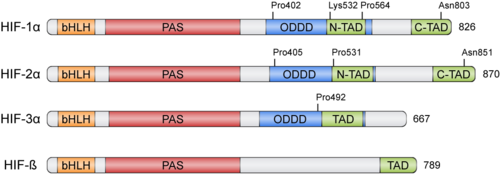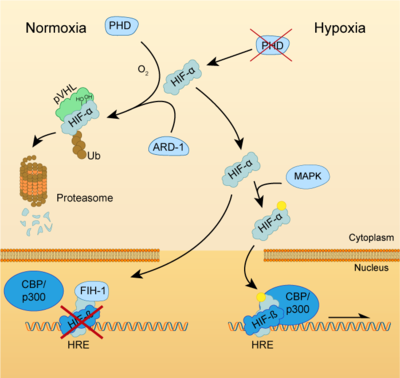Hypoxia-Inducible Factors
From Proteopedia
(Difference between revisions)
| Line 42: | Line 42: | ||
METER FRASE INTRODUCTORIA AQUI | METER FRASE INTRODUCTORIA AQUI | ||
===HIF activators=== | ===HIF activators=== | ||
| + | |||
Due to the protective role of HIF, therapies based on small-molecules that stabilize HIF-α have attracted a lot of attention. In pathologies such as ischemia or [https://en.wikipedia.org/wiki/Stroke stroke], HIF activation could help to reduce the damage done by the lack of oxygen and restore tissue functionality. This objective can be achieved by two different ways: inhibition of HIF-PHD pathway or without the inhibition of PHDs <ref>PMID: 30671433</ref>. | Due to the protective role of HIF, therapies based on small-molecules that stabilize HIF-α have attracted a lot of attention. In pathologies such as ischemia or [https://en.wikipedia.org/wiki/Stroke stroke], HIF activation could help to reduce the damage done by the lack of oxygen and restore tissue functionality. This objective can be achieved by two different ways: inhibition of HIF-PHD pathway or without the inhibition of PHDs <ref>PMID: 30671433</ref>. | ||
====HIF-1α Up-Regulation via Inhibition of PHD Pathway==== | ====HIF-1α Up-Regulation via Inhibition of PHD Pathway==== | ||
| - | This group includes the majority of HIF-1α | + | This group includes the majority of HIF-1α upregulators. PHDs inhibition can be achieved through different interventions: |
=====Iron chelators and competitors===== | =====Iron chelators and competitors===== | ||
Iron chelators reduce the number of free iron (Fe2+) by binding tightly to it. In this way, PHD enzymes do not have enough available iron to carry out the hydroxylation reaction and the expression of HIF-1α is upregulated. Also, iron competitors such as Co2+ or Mn2+ can be used <ref>PMID: 30671433</ref>. [https://en.wikipedia.org/wiki/Deferoxamine '''Deferoxamine (DFO)'''] and [https://en.wikipedia.org/wiki/Mimosine '''mimosine'''] were the first iron chelators to mediate HIF-1α neuroprotection. Pre-treatment with DFO protected neurons from oxidative stress-induced death by inhibiting PHDs, therefore increasing mRNA and protein expression of both HIF-1α and its controlled genes <ref>PMID: 10559391</ref>. [https://en.wikipedia.org/wiki/2,2%E2%80%B2-Bipyridine '''2,2-dipyridyl'''] ('''DP''') is a liposoluble iron chelator that upregulates HIF-1α expression. Treatment with this drug decreased expansion of tissue damage after ischemia and protected neurons and endothelial cells by decreasing the amount of [https://en.wikipedia.org/wiki/Reactive_oxygen_species '''reactive oxygen species'''] ('''ROS''') <ref>PMID: 15280435</ref>. | Iron chelators reduce the number of free iron (Fe2+) by binding tightly to it. In this way, PHD enzymes do not have enough available iron to carry out the hydroxylation reaction and the expression of HIF-1α is upregulated. Also, iron competitors such as Co2+ or Mn2+ can be used <ref>PMID: 30671433</ref>. [https://en.wikipedia.org/wiki/Deferoxamine '''Deferoxamine (DFO)'''] and [https://en.wikipedia.org/wiki/Mimosine '''mimosine'''] were the first iron chelators to mediate HIF-1α neuroprotection. Pre-treatment with DFO protected neurons from oxidative stress-induced death by inhibiting PHDs, therefore increasing mRNA and protein expression of both HIF-1α and its controlled genes <ref>PMID: 10559391</ref>. [https://en.wikipedia.org/wiki/2,2%E2%80%B2-Bipyridine '''2,2-dipyridyl'''] ('''DP''') is a liposoluble iron chelator that upregulates HIF-1α expression. Treatment with this drug decreased expansion of tissue damage after ischemia and protected neurons and endothelial cells by decreasing the amount of [https://en.wikipedia.org/wiki/Reactive_oxygen_species '''reactive oxygen species'''] ('''ROS''') <ref>PMID: 15280435</ref>. | ||
| Line 51: | Line 52: | ||
=====Alternative mechanism of action===== | =====Alternative mechanism of action===== | ||
Instead of sequestering Fe2+ ions or mimicking 2-oxoglutarate binding, some molecules can bind directly into the active site of PHDs. '''FG-4497''' is a PHD inhibitor that stabilizes HIF-1α and upregulates VEGF and EPO in murine cell lines. It has also been shown to enhance cell survival following oxygen-glucose deprivation. Indeed, intraperitoneal administration of FG-4497 can reduce infarct size<ref>PMID: 24409307</ref>. On the other hand, [https://en.wikipedia.org/wiki/Folate '''Folic acid'''] ('''FA''') can directly inhibit PHD2, FIH-1 and pVHL. Post-ischemic ''in vivo'' treatments showed that FA upregulated HIF-1α and its target genes<ref>PMID: 29542054</ref>. | Instead of sequestering Fe2+ ions or mimicking 2-oxoglutarate binding, some molecules can bind directly into the active site of PHDs. '''FG-4497''' is a PHD inhibitor that stabilizes HIF-1α and upregulates VEGF and EPO in murine cell lines. It has also been shown to enhance cell survival following oxygen-glucose deprivation. Indeed, intraperitoneal administration of FG-4497 can reduce infarct size<ref>PMID: 24409307</ref>. On the other hand, [https://en.wikipedia.org/wiki/Folate '''Folic acid'''] ('''FA''') can directly inhibit PHD2, FIH-1 and pVHL. Post-ischemic ''in vivo'' treatments showed that FA upregulated HIF-1α and its target genes<ref>PMID: 29542054</ref>. | ||
| - | ====HIF-1α Up-Regulation Without the Inhibition of PHDs==== | ||
| + | ====HIF-1α Up-Regulation Without the Inhibition of PHDs==== | ||
| + | These kinds of molecules have been recently discovered. They can upregulate HIF-1α in different ways: | ||
| + | *'''MiR-335''' is a [https://en.wikipedia.org/wiki/MicroRNA '''microRNA'''] that directly regulates HIF-1α. Treatment with this microRNA decreased infarct volume in rat models when administered early after ischemia induction, but inhibition of miR-335 in later phases surprisingly had beneficial effects. This could be due to the biphasic nature of HIF-1α<ref>PMID: 26030758</ref>. | ||
| + | *'''Proteasome inhibitors''' such as [https://en.wikipedia.org/wiki/MG132 '''MG-132'''] can stabilize HIF-1α, with better prognosis when combined with DMOG. Other proteasome inhibitors, like [https://en.wikipedia.org/wiki/Epoxomicin '''epoxomicin'''] or '''Bsc2118'''<ref>PMID: 23169919</ref>, are also able to reduce infarct size and promote cell survival in ischemic conditions, being even more effective than PHDs inhibitors<ref>PMID: 28566998</ref>. | ||
Revision as of 13:15, 24 November 2020
| |||||||||||
References
- ↑ Ke Q, Costa M. Hypoxia-inducible factor-1 (HIF-1). Mol Pharmacol. 2006 Nov;70(5):1469-80. doi: 10.1124/mol.106.027029. Epub 2006 Aug, 3. PMID:16887934 doi:http://dx.doi.org/10.1124/mol.106.027029
- ↑ Wu D, Potluri N, Lu J, Kim Y, Rastinejad F. Structural integration in hypoxia-inducible factors. Nature. 2015 Aug 5. doi: 10.1038/nature14883. PMID:26245371 doi:http://dx.doi.org/10.1038/nature14883
- ↑ Goldberg MA, Dunning SP, Bunn HF. Regulation of the erythropoietin gene: evidence that the oxygen sensor is a heme protein. Science. 1988 Dec 9;242(4884):1412-5. doi: 10.1126/science.2849206. PMID:2849206 doi:http://dx.doi.org/10.1126/science.2849206
- ↑ Semenza GL, Nejfelt MK, Chi SM, Antonarakis SE. Hypoxia-inducible nuclear factors bind to an enhancer element located 3' to the human erythropoietin gene. Proc Natl Acad Sci U S A. 1991 Jul 1;88(13):5680-4. doi: 10.1073/pnas.88.13.5680. PMID:2062846 doi:http://dx.doi.org/10.1073/pnas.88.13.5680
- ↑ Wang GL, Jiang BH, Rue EA, Semenza GL. Hypoxia-inducible factor 1 is a basic-helix-loop-helix-PAS heterodimer regulated by cellular O2 tension. Proc Natl Acad Sci U S A. 1995 Jun 6;92(12):5510-4. PMID:7539918
- ↑ Reyes H, Reisz-Porszasz S, Hankinson O. Identification of the Ah receptor nuclear translocator protein (Arnt) as a component of the DNA binding form of the Ah receptor. Science. 1992 May 22;256(5060):1193-5. PMID:1317062
- ↑ Dames SA, Martinez-Yamout M, De Guzman RN, Dyson HJ, Wright PE. Structural basis for Hif-1 alpha /CBP recognition in the cellular hypoxic response. Proc Natl Acad Sci U S A. 2002 Apr 16;99(8):5271-6. PMID:11959977 doi:http://dx.doi.org/10.1073/pnas.082121399
- ↑ Loboda A, Jozkowicz A, Dulak J. HIF-1 and HIF-2 transcription factors--similar but not identical. Mol Cells. 2010 May;29(5):435-42. doi: 10.1007/s10059-010-0067-2. Epub 2010 Apr, 12. PMID:20396958 doi:http://dx.doi.org/10.1007/s10059-010-0067-2
- ↑ Manalo DJ, Rowan A, Lavoie T, Natarajan L, Kelly BD, Ye SQ, Garcia JG, Semenza GL. Transcriptional regulation of vascular endothelial cell responses to hypoxia by HIF-1. Blood. 2005 Jan 15;105(2):659-69. doi: 10.1182/blood-2004-07-2958. Epub 2004 Sep , 16. PMID:15374877 doi:http://dx.doi.org/10.1182/blood-2004-07-2958
- ↑ Bruick RK, McKnight SL. A conserved family of prolyl-4-hydroxylases that modify HIF. Science. 2001 Nov 9;294(5545):1337-40. doi: 10.1126/science.1066373. Epub 2001, Oct 11. PMID:11598268 doi:http://dx.doi.org/10.1126/science.1066373
- ↑ Kamura T, Sato S, Iwai K, Czyzyk-Krzeska M, Conaway RC, Conaway JW. Activation of HIF1alpha ubiquitination by a reconstituted von Hippel-Lindau (VHL) tumor suppressor complex. Proc Natl Acad Sci U S A. 2000 Sep 12;97(19):10430-5. PMID:10973499 doi:http://dx.doi.org/10.1073/pnas.190332597
- ↑ Jeong JW, Bae MK, Ahn MY, Kim SH, Sohn TK, Bae MH, Yoo MA, Song EJ, Lee KJ, Kim KW. Regulation and destabilization of HIF-1alpha by ARD1-mediated acetylation. Cell. 2002 Nov 27;111(5):709-20. PMID:12464182
- ↑ Lando D, Peet DJ, Whelan DA, Gorman JJ, Whitelaw ML. Asparagine hydroxylation of the HIF transactivation domain a hypoxic switch. Science. 2002 Feb 1;295(5556):858-61. doi: 10.1126/science.1068592. PMID:11823643 doi:http://dx.doi.org/10.1126/science.1068592
- ↑ Richard DE, Berra E, Gothie E, Roux D, Pouyssegur J. p42/p44 mitogen-activated protein kinases phosphorylate hypoxia-inducible factor 1alpha (HIF-1alpha) and enhance the transcriptional activity of HIF-1. J Biol Chem. 1999 Nov 12;274(46):32631-7. doi: 10.1074/jbc.274.46.32631. PMID:10551817 doi:http://dx.doi.org/10.1074/jbc.274.46.32631
- ↑ Davis CK, Jain SA, Bae ON, Majid A, Rajanikant GK. Hypoxia Mimetic Agents for Ischemic Stroke. Front Cell Dev Biol. 2019 Jan 8;6:175. doi: 10.3389/fcell.2018.00175. eCollection, 2018. PMID:30671433 doi:http://dx.doi.org/10.3389/fcell.2018.00175
- ↑ Davis CK, Jain SA, Bae ON, Majid A, Rajanikant GK. Hypoxia Mimetic Agents for Ischemic Stroke. Front Cell Dev Biol. 2019 Jan 8;6:175. doi: 10.3389/fcell.2018.00175. eCollection, 2018. PMID:30671433 doi:http://dx.doi.org/10.3389/fcell.2018.00175
- ↑ Zaman K, Ryu H, Hall D, O'Donovan K, Lin KI, Miller MP, Marquis JC, Baraban JM, Semenza GL, Ratan RR. Protection from oxidative stress-induced apoptosis in cortical neuronal cultures by iron chelators is associated with enhanced DNA binding of hypoxia-inducible factor-1 and ATF-1/CREB and increased expression of glycolytic enzymes, p21(waf1/cip1), and erythropoietin. J Neurosci. 1999 Nov 15;19(22):9821-30. PMID:10559391
- ↑ Demougeot C, Van Hoecke M, Bertrand N, Prigent-Tessier A, Mossiat C, Beley A, Marie C. Cytoprotective efficacy and mechanisms of the liposoluble iron chelator 2,2'-dipyridyl in the rat photothrombotic ischemic stroke model. J Pharmacol Exp Ther. 2004 Dec;311(3):1080-7. doi: 10.1124/jpet.104.072744. Epub , 2004 Jul 27. PMID:15280435 doi:http://dx.doi.org/10.1124/jpet.104.072744
- ↑ Nagel S, Papadakis M, Chen R, Hoyte LC, Brooks KJ, Gallichan D, Sibson NR, Pugh C, Buchan AM. Neuroprotection by dimethyloxalylglycine following permanent and transient focal cerebral ischemia in rats. J Cereb Blood Flow Metab. 2011 Jan;31(1):132-43. doi: 10.1038/jcbfm.2010.60. Epub, 2010 Apr 21. PMID:20407463 doi:http://dx.doi.org/10.1038/jcbfm.2010.60
- ↑ Reischl S, Li L, Walkinshaw G, Flippin LA, Marti HH, Kunze R. Inhibition of HIF prolyl-4-hydroxylases by FG-4497 reduces brain tissue injury and edema formation during ischemic stroke. PLoS One. 2014 Jan 7;9(1):e84767. doi: 10.1371/journal.pone.0084767. eCollection , 2014. PMID:24409307 doi:http://dx.doi.org/10.1371/journal.pone.0084767
- ↑ Davis CK, Nampoothiri SS, Rajanikant GK. Folic Acid Exerts Post-Ischemic Neuroprotection In Vitro Through HIF-1alpha Stabilization. Mol Neurobiol. 2018 Nov;55(11):8328-8345. doi: 10.1007/s12035-018-0982-3. Epub, 2018 Mar 14. PMID:29542054 doi:http://dx.doi.org/10.1007/s12035-018-0982-3
- ↑ Liu FJ, Kaur P, Karolina DS, Sepramaniam S, Armugam A, Wong PT, Jeyaseelan K. MiR-335 Regulates Hif-1alpha to Reduce Cell Death in Both Mouse Cell Line and Rat Ischemic Models. PLoS One. 2015 Jun 1;10(6):e0128432. doi: 10.1371/journal.pone.0128432., eCollection 2015. PMID:26030758 doi:http://dx.doi.org/10.1371/journal.pone.0128432
- ↑ Doeppner TR, Mlynarczuk-Bialy I, Kuckelkorn U, Kaltwasser B, Herz J, Hasan MR, Hermann DM, Bahr M. The novel proteasome inhibitor BSc2118 protects against cerebral ischaemia through HIF1A accumulation and enhanced angioneurogenesis. Brain. 2012 Nov;135(Pt 11):3282-97. doi: 10.1093/brain/aws269. PMID:23169919 doi:http://dx.doi.org/10.1093/brain/aws269
- ↑ Badawi Y, Shi H. Relative Contribution of Prolyl Hydroxylase-Dependent and -Independent Degradation of HIF-1alpha by Proteasomal Pathways in Cerebral Ischemia. Front Neurosci. 2017 May 17;11:239. doi: 10.3389/fnins.2017.00239. eCollection, 2017. PMID:28566998 doi:http://dx.doi.org/10.3389/fnins.2017.00239
Proteopedia Page Contributors and Editors (what is this?)
Gonzalo Garcia-Martin, Michal Harel, Carmen Paredes Yubero, Rocío Moreno


